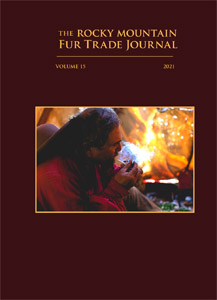$19.95
An annual academic peer-reviewed publication intended to further the knowledge and discussion of the Rocky Mountain fur trade era and provide an avenue for researchers to showcase their work.
Full color, perfect bound, 8″ x 11″, softback, 152 pages.
Journal is provided FREE with a purchase of an annual membership!!! Click here to purchase a membership now!
Description
2021 Rocky Mountain Fur Trade Journal, Volume 15
In the Absence of the Indians: Looting of American Indian Graves During the Fur Trade
by Mark van de Logt, PhD, and Dan Jibréus
The article tells of how 19th century scientists, ethnologists and naturalists, sometimes with the help of fur traders, took human remains from Native burials throughout the West. At the time, it was considered leading edge science to categorize the different peoples of the world based on precise measurements of their skulls. The list of these skull collectors is a surprising who’s who of professional and amateur naturalists and western travelers. Central to the story is a skull taken from an Arikara grave in 1844 that has spent more than a century in a collection in Sweden, and one of the author’s efforts to return it to its people.
Welcome to my Indian Weed! Tobacco and the Fur Trade
by James A. Hanson, PhD
The fur trade connected Native tribes to each other and brought the goods of the world to them, and vice versa. Tobacco was a trade item that made the journey from its origins in the Americas to the rest of the world and back again as an item of international trade.
Grand Ignace: Apostle of the Flatheads
by George Capps
History occasionally remembers ordinary people who have extraordinary influences on events beyond their lifetimes. Grand Ignace was an Iroquois trapper, raised near Montreal, who settled among the Salish people of what is now Montana. Brought up in the Roman Catholic faith, Ignace became part of a quest for missionary priests to bring the religion of his youth to his new homeland. Over time, his story became wrapped in myth, and his identity obscured.
Sublette’s Trace: The Fur Trade’s Influence on Emigrant Trails
by Jim Hardee
The trails used by tens of thousands of westbound emigrants following the rendezvous era were pioneered by trappers, who in turn learned the routes by observing Native American seasonal travel. Jim Hardee’s article examines and locates a fur trade road that grew into an emigrant trail which outlived its original namesake.
The Fort Hall Account Book: Sales Patterns and Seasonal Cycles
by Michael P. Schaubs
The accounts of Nathaniel Wyeth’s Fort Hall provide an invaluable and early record of the business side of the mountain fur trade. The lists of goods brought overland from the settlements, or by ship to the Columbia River to be packed to Fort Hall, tell the story of what was available to customers. Goods recorded in an inventory, and sales recorded on a ledger, reflect the daily life of the fort: the statistics provide insights the narrative accounts of Fort Hall do not contain.
For a further description and Editor’s Notes see Volume 15 – 2021
Sublette County Historical Society, 2021
Additional information
| Weight | 16 oz |
|---|---|
| Dimensions | 11 × 8 × .5 in |

